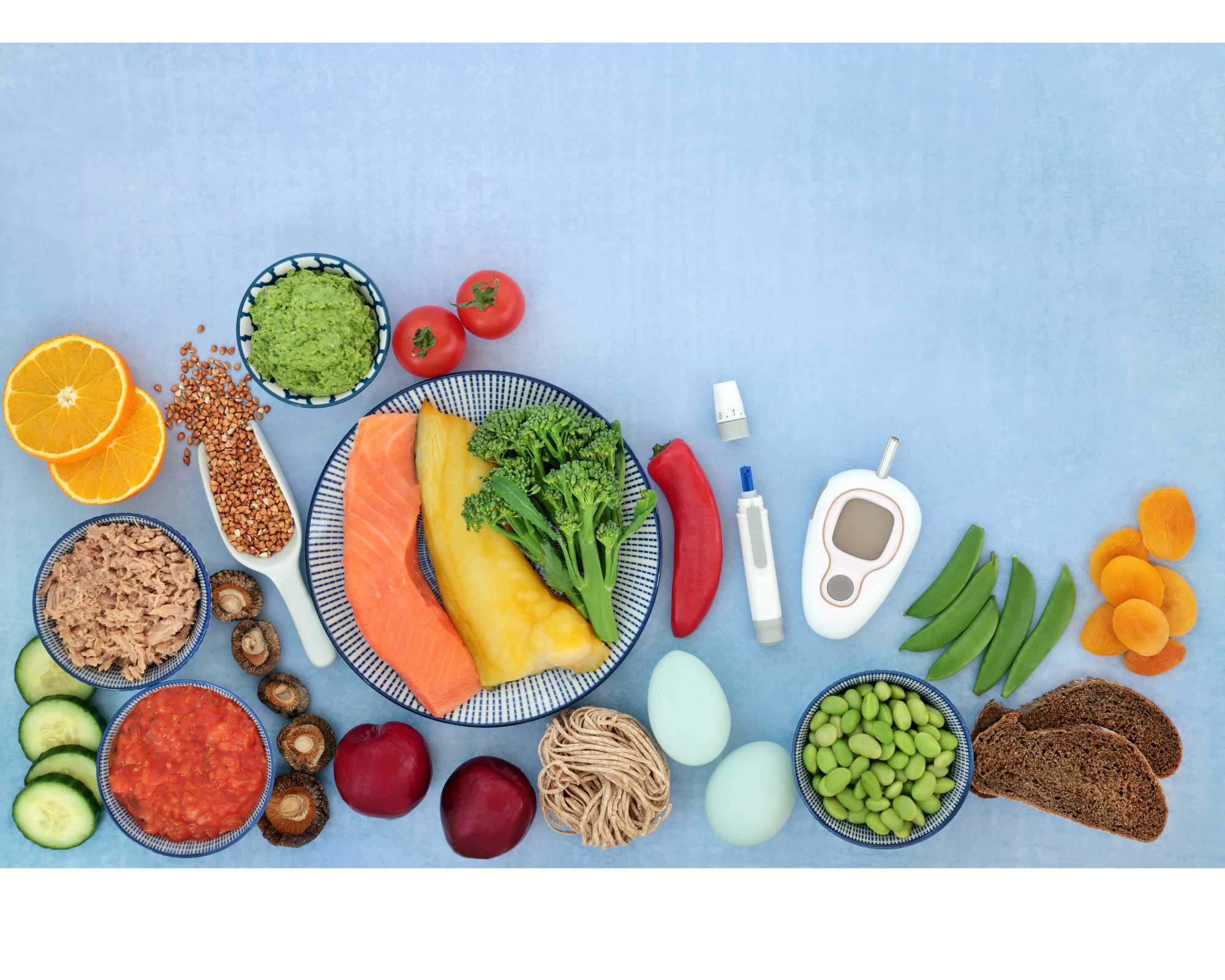
The Hidden Power of Fasting Intermittent: Unlock Natural Healing
Fasting intermittently is a popular way to improve health and wellness. It involves alternating between eating and fasting periods, allowing flexibility for those who want

Easy ways to control blood sugar levels are beneficial in today’s fast-paced world. Easy-to-access foods and other unhealthy conveniences make unhealthy decisions more likely. Thus, it is critical to focus on regaining control of our health.
Whether you are managing diabetes, trying to prevent it, or looking to improve your health, it is essential to manage stable sugar levels.
The good news is that doing so does not have to be difficult or time-consuming. In this article, we’ll look at easy ways to control your blood sugar levels that will help you to live a balanced life with loads of energy.

Blood sugar levels or blood glucose levels refer to the concentration of glucose (sugar) present in your bloodstream at any given time. Glucose is a vital source of energy for the body’s cells. It comes from the carbohydrates we consume in our diet. Maintaining stable sugar levels is crucial for your health and well-being. Both high and low sugar levels can have negative effects on your health.
The Centers for Disease Control and Prevention (CDC) reports that 13% of U.S. adults live with diabetes. Another 34.5% have pre-diabetes. This means that close to 50% of all U.S. adults have diabetes or pre-diabetes.
Blood sugar levels can vary based on different factors such as whether a person has recently eaten, their age, and if they have any underlying health conditions.
Guidelines for sugar levels for individuals without diabetes:
Fasting Blood Sugar (Fasting Plasma Glucose, FPG):
Normal: Less than 100 mg/dL (5.6 mmol/L)
Pre-diabetes (impaired fasting glucose): 100-125 mg/dL (5.6-6.9 mmol/L)
Diabetes: 126 mg/dL (7.0 mmol/L) or higher
Postprandial Blood Sugar (After Eating, 2 Hours After a Meal):
Normal: Less than 140 mg/dL (7.8 mmol/L)
Pre-diabetes: 140-199 mg/dL (7.8-11.0 mmol/L)
Diabetes: 200 mg/dL (11.1 mmol/L) or higher
It’s important to note that these values are general guidelines. Values can vary depending on the laboratory and measurement units used. Sugar level goals depend on factors such as age, health status, and treatment plan. People with diabetes often have sugar targets recommended by their healthcare providers.
Uncontrolled sugar levels can lead to a range of health issues. Diabetes is a chronic condition caused by high sugar levels (hyperglycemia). This is due to the body’s inability to use or produce insulin.
The American Diabetes Association (ADA) recommends diabetics to manage their carb intake. There are two main types of diabetes: type 1 diabetes and type 2 diabetes.
The following are diseases and complications caused by bad sugar levels:
This is an autoimmune condition. The immune system attacks and destroys the insulin-producing cells in the pancreas. People with type 1 diabetes need insulin injections or an insulin pump. This is to regulate their blood sugar levels. Uncontrolled blood sugar levels in type 1 diabetes can lead to:
Diabetic ketoacidosis (DKA): A serious condition where high blood sugar levels lead to the production of ketones. This can cause a dangerous metabolic imbalance.
Hypoglycemia: Low blood sugar levels can result in symptoms like shakiness, confusion, and even loss of consciousness if severe.
This type of diabetes is characterized by insulin resistance, where the body’s cells do not respond effectively to insulin. Over time, the pancreas might not produce enough insulin to maintain normal sugar levels. Uncontrolled blood sugar levels in type 2 diabetes can lead to:
Cardiovascular complications: Diabetes increases the risk of heart disease, stroke, and high blood pressure.
Nerve damage (neuropathy): High blood sugar can damage nerves. This can lead to pain, tingling, and numbness, often in your limbs.
Kidney damage (nephropathy): Uncontrolled diabetes can lead to kidney damage and even kidney failure.
Eye problems (retinopathy): Diabetes can damage the blood vessels in the retina. This can lead to a loss of vision.
Foot complications: Nerve damage and poor circulation can lead to foot ulcers and infections. This could result in requiring amputation.
Slow wound healing: High blood sugar levels can impair the body’s ability to heal wounds.
This type of diabetes occurs during pregnancy. Elevated sugar levels are a symptom. Gestational diabetes can lead to complications for both the mother and the baby. This could cause a higher risk of cesarean delivery, preeclampsia, and macrosomia (large birth weight).
Before developing type 2 diabetes, many people go through a phase of pre-diabetes. This is when sugar levels are higher than normal but not high enough to diagnose diabetes. Without intervention, pre-diabetes can progress to type 2 diabetes.
This is a group of conditions including obesity, high blood pressure, high blood sugar, and abnormal cholesterol levels. Metabolic syndrome increases the risk of heart disease, stroke, and type 2 diabetes.
It is important to manage your sugar levels to prevent these health problems. You can manage them through medication, lifestyle choices, and regular monitoring.
Focus on a balanced diet for healthy sugar levels. This should include a variety of whole healthy foods such as vegetables, fruits, whole grains, and healthy fats. Avoid or limit processed foods, sugary snacks, and sugary beverages. Magnesium-rich foods are very beneficial to blood sugar control.
Pay attention to your carbohydrate intake. Carbohydrates have the most direct impact on sugar levels. Choose complex or refined carbohydrates when you eat carbs. Examples of these carbs are whole wheat pasta or brown rice. Choose carbs with a low glycemic index (low GI foods). Low GI foods release sugar into the bloodstream more gradually. This can help prevent spikes in blood sugar levels.
Be mindful of portion sizes to avoid overeating. Smaller food sizes help control sugar spikes. Using smaller plates and bowls can help with portion control.
Frequent, Smaller Meals
Instead of three large meals, consider eating smaller, balanced meals throughout the day. This can help keep sugar levels stable and prevent extreme fluctuations. Therefore, it will control blood sugar levels naturally.
Incorporate fiber-rich foods into your diet. Whole grains, non-starchy vegetables, legumes, and fruits are all good options. Fiber slows down the digestion and absorption of carbohydrates. Thus, helps prevent sudden spikes in your blood glucose level. The recommended daily intake of fiber is about 25 grams for women and 35 grams for men. That is roughly 14 grams for every 1,000 calories.
Including lean proteins in your meals can help regulate sugar levels. It will also keep you feeling full for longer. However, vegan options of tofu and beans will also regulate your sugar level.
Choose sources of healthy fat. Healthy fats can be beneficial for managing sugar levels when included as part of a balanced diet. They can help slow down the digestion and absorption of carbohydrates, preventing rapid spikes in blood sugar.
If you have diabetes, monitoring your carbohydrates is important. Counting carbs will help make the right choices on meals and insulin dosing. Furthermore, monitoring your carbohydrates will reduce the chance of too much glucose. Too much glucose causes blood sugar spikes.

Exercising improves insulin sensitivity and lowers sugar levels. A combination of walking, jogging, or cycling and strength training is a good choice. Regular exercise will help maintain a healthy weight. As a result, exercise reduces the chance of life-threatening complications.
Drink plenty of water throughout the day. Dehydration can affect blood sugar levels and lead to complications.
Sugary sodas and fruit juices can cause rapid spikes in sugar. Opt for water, herbal tea, or beverages sweetened with non-caloric sweeteners if needed.
Practice techniques to reduce your stress. Meditation, deep breathing, yoga, or mindfulness can reduce stress. Stress hormones can impact sugar levels.
Make getting enough quality sleep each night a priority. Sleep deprivation can affect insulin sensitivity and lead to imbalanced sugar levels.
Sleep quality has a link to magnesium levels. Sufficient levels of magnesium can improve sleep quality. Therefore, it will help balance sugar levels.
Monitoring your sugar level if you have diabetes is important. This can help you make timely adjustments to your diet, medication, or insulin regimen. This can be done with an easy blood sugar test.

Balancing blood sugar can be a struggle when facing certain diseases. The Well of Life’s Blood Sugar Support is a combination of herbs. The herbs support sugar levels and improve the health of your pancreas. Therefore, improves insulin levels.
This is an advanced formula that combines 20 herbs, vitamins, and minerals. Together they support optimal sugar levels, healthy cholesterol, metabolism, and more.

Dark chocolate
Olive oil
Oats
Sweet potatoes
Blueberries and most fruits (except for pineapples and melons)
Fish
Broccoli
Oatmeal and oat bran
Most nuts and seeds
Garlic
High blood sugar (hyperglycemia) is a symptom of diabetes or high sugar levels. It occurs when the body doesn’t produce enough insulin or is unable to use insulin to regulate sugar levels.
The following are some signs and symptoms that might show high sugar levels:
Feeling thirsty and needing to drink more fluids than usual can be a sign of high blood sugar. The body tries to flush out excess sugar through urine, leading to dehydration and increased thirst.
High sugar levels can cause the kidneys to work harder to filter and remove excess sugar from the blood, leading to more frequent trips to the bathroom.
Despite eating, you may still feel very hungry. This happens because the body’s cells are unable to access the glucose they need for energy due to insulin resistance or deficiency.
High sugar can lead to a lack of energy and fatigue. Cells are not getting the energy they need due to the inability to use glucose.
High blood sugar levels can affect the fluid balance in the eyes. This could lead to temporary changes in vision.
Elevated blood sugar levels can impair the body’s ability to heal properly. Wounds and cuts may take longer to heal than usual.
Prolonged high sugar levels can damage nerves. This leads to sensations of tingling, numbness, or burning, particularly in the hands and feet. This condition is diabetic neuropathy.
High blood sugar weakens the immune system. Therefore, making it more difficult for the body to fight off infections. As a result, there is a decrease in disease control. Yeast infections (especially in women) and urinary tract infections are common.
Unexplained weight loss can occur due to the body breaking down muscle and fat for energy since it can’t effectively use glucose.
Mood changes, irritability, and difficulty concentrating can result from fluctuations in sugar levels.
High blood sugar can lead to dry mouth and dry, itchy skin.
It’s important to note that these symptoms can vary from person to person. Some individuals with high sugar might not experience any symptoms at all. Early detection and management of high blood sugar are essential. This will prevent complications associated with diabetes.
Low blood sugar (hypoglycemia) occurs when your blood sugar levels drop below normal levels. This is common in individuals with diabetes who take insulin or certain medications to manage their sugar. Recognizing the signs of low sugar is important because if left untreated, it can lead to confusion, unconsciousness, and even be life-threatening.
Here are some signs and symptoms of low blood sugar:
Feeling shaky, especially in your hands, is a common early sign of low blood sugar.
Experiencing sudden and excessive sweating. This is even when you’re not engaged in physical activity or a warm environment. Excessive sweating can be a symptom of low blood sugar.
Feeling very hungry, often accompanied by an intense craving for sugary foods. This is a sign that your body is trying to raise your blood sugar levels.
Feeling dizzy, lightheaded, or even faint. This is a result of low blood sugar levels affecting brain function.
Low sugar can lead to confusion, difficulty concentrating, and changes in cognitive function.
Mood changes, irritability, and sudden mood swings can be symptoms of low blood sugar.
Feeling weak, tired, or lethargic. This is a result of inadequate glucose supply to the body’s cells.
A headache, often described as a dull or pounding sensation, can be a symptom of low blood sugar.
Blurred vision or difficulty focusing may occur due to changes in fluid balance in the eyes.
Sensations of numbness or tingling around the lips and tongue can be a symptom of low sugar.
Slurred speech or difficulty finding the right words is a result of the low blood sugar’s effect on the brain’s functions.
If you experience symptoms of low blood sugar, it’s important to take action as quickly as possible. Eat or drink something with fast-acting carbohydrates, such as a glucose tablet, fruit juice, or a regular soft drink.
Individual responses to low sugar can vary. Therefore, it’s important to work with your healthcare provider to develop a personalized plan for managing low-sugar episodes. Especially if you have diabetes or take medications that can lower sugar levels.
In conclusion, maintaining healthy blood sugar levels is essential for well-being. Especially individuals with or at the risk of diabetes. There are many ways of controlling your sugar levels. Most importantly adopting a balanced and mindful approach to eating. Lifestyle choices such as exercise, sleep routine, and stress levels are contributing factors. You can control your levels and promote better health by following these simple ways to control your blood sugar levels.

Fasting intermittently is a popular way to improve health and wellness. It involves alternating between eating and fasting periods, allowing flexibility for those who want

Gluten-free lifestyles might seem intimidating, particularly if you’re just getting started. All sorts of tasty and healthy options that you may not have thought of

Basic Health for Men: A Gentle Guide for a Better Lifestyle Health for men is a topic that is often overlooked because there are more

The Power of A Digital Detox: Revitalizing Your Life A digital detox is needed now more than ever, as digital devices are our most valuable

The Role of Chlorine Dioxide in Holistic Healing: Alternative Therapies Chlorine dioxide (CDS), also known as the miracle solution, has been underestimated for many years.

A vertigo dizziness remedy can be difficult to find as vertigo can be an unsettling experience. This often leads to a spinning sensation and feeling


This website or its third-party tools use cookies, which are necessary for its functioning and required to achieve the purposes illustrated in the cookie policy. You accept the use of cookies by closing or dismissing this notice, by clicking a link or button or by continuing to browse otherwise.
3 thoughts on “Easy Ways to Control Blood Sugar Levels”
thank you.I will save this article to give to someone I know who I suspect may have a sugar problem. Nicely informative.
I do not operate a credit card. Can I order via bank transfer?
Please advise.
AM
Hello Arnold, please call customer care on 1-888-744-2614 or Email on: support@welloflife.com.